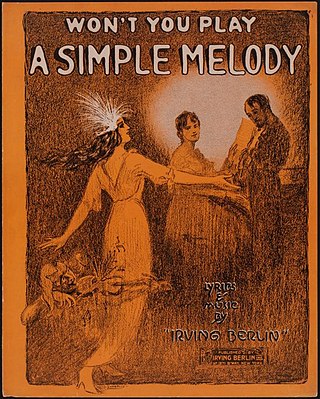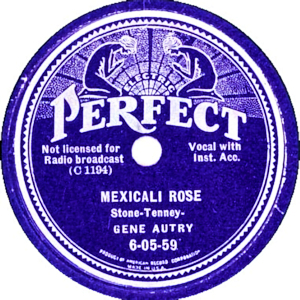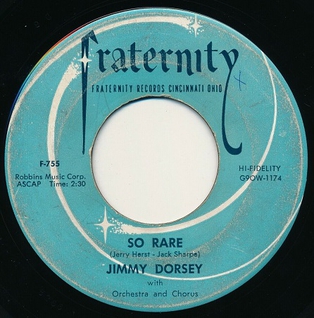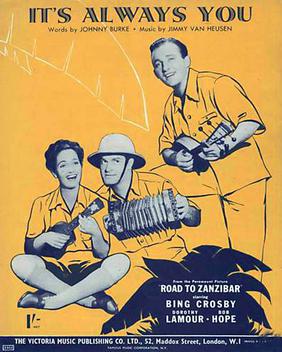"Around the World" is the theme tune from the 1956 movie Around the World in 80 Days. In the film, only an instrumental version of the song appeared, although the vocal version has become the better known one. The song was written by Harold Adamson and Victor Young; Young died in 1956, several weeks after the film's release, and he received the Academy Award for Best Music, Scoring of a Dramatic or Comedy Picture posthumously. Young's orchestral version was a #13 hit on the Billboard charts in 1957. The recording by Bing Crosby was the B-side of the Victor Young version in 1957, on Festival SP45-1274 in Australia, and was a joint charting success.
"If I Give My Heart to You" is a popular song written by Jimmy Brewster, Jimmie Crane, and Al Jacobs. The most popular versions of the song were recorded by Doris Day and by Denise Lor; both charted in 1954.
"Papa Loves Mambo" is a popular song written by Al Hoffman, Dick Manning, and Bix Reichner and released in 1954.
"Pledging My Love" is a blues ballad. It was written by Ferdinand Washington and Don Robey and published in 1954.

"Pretty Baby" is a song written by Tony Jackson during the Ragtime era. The song was remembered as being prominent in Jackson's repertory before he left New Orleans in 1912, but was not published until 1916.

"Play a Simple Melody" is a song from the 1914 musical, Watch Your Step, with words and music by Irving Berlin.

"By the Light of the Silvery Moon" or "By the Light of the Silv'ry Moon" is a popular love song. The music was written by Gus Edwards, and the lyrics by Edward Madden. The song was published in 1909 and first performed on stage by Lillian Lorraine in the Ziegfeld Follies of 1909. It was one of a series of moon-related Tin Pan Alley songs of the era. The song was also used in the short-lived Broadway show Miss Innocence when it was sung by Frances Farr.
"Wedding Bells (Are Breaking Up That Old Gang Of Mine)" is a popular barbershop song composed by Sammy Fain with lyrics by Irving Kahal and Willie Raskin. Published in 1929, the song laments the loss of childhood friendships as they are replaced by adult relationships.

"Where the Blue of the Night (Meets the Gold of the Day)" was the theme Bing Crosby selected for his radio show. It was recorded in November 1931 with Bennie Krueger and his Orchestra. The song was featured in a Mack Sennett movie short starring Bing Crosby. Crosby recorded the song on several occasions starting with the November 23, 1931 version with Bennie Kruger and his Orchestra. He next recorded it on July 20, 1940 with The Paradise Island Trio. On July 17, 1945 he recorded it with John Scott Trotter and his Orchestra and his final recording was on April 21, 1954 with Buddy Cole and his Trio for his Musical Autobiography set.
"This Can't Be Love" is a show tune and a popular song from the 1938 Rodgers and Hart musical The Boys from Syracuse when it was sung by Eddie Albert and Marcy Westcott. The lyrics poke fun at the common depiction of love in popular songs as a host of malignant symptoms, saying, "This can't be love because I feel so well."
"(Love Is) The Tender Trap" is a popular song composed by Jimmy Van Heusen, with lyrics by Sammy Cahn.

"Amor", also known as "Amor Amor" and "Amor Amor Amor" is a popular song published in 1943.

"Nobody's Sweetheart", also known as "Nobody's Sweetheart Now" and "You're Nobody's Sweetheart Now", is a popular song, written in 1924, with music by Billy Meyers and Elmer Schoebel, and lyrics by Gus Kahn and Ernie Erdman. The song is a jazz and pop standard.
"I Cried for You" is a pop and jazz standard with music written by Gus Arnheim and Abe Lyman, with lyrics by Arthur Freed. It was introduced by Abe Lyman and His Orchestra in 1923. The recording by Benny Krueger and His Orchestra the same year peaked at number 2 for two weeks and remained in the charts for ten weeks at large. Also in 1923 another interpretation of the song by the Columbians reached number 14 for one week. 15 years later in 1938 two new recordings peaked both number 13 in the Billboard charts, Bunny Berigan and His Orchestra with Kathleen Lane on vocals and an interpretation by Bing Crosby. Glen Gray and his Casa Loma Orchestra followed the next year, peaking at number 6, and in 1942 Harry James' recording was the last to get into the Billboard charts, peaking at number 19.

"Mexicali Rose" is a popular song composed by bandleader and pianist Jack Breckenridge Tenney in the early 1920s, when he and his seven piece orchestra played the hotels and clubs of the Calexico and Mexicali border. The song became a hit in the mid-1930s, thanks to Gene Autry and Bing Crosby, around the same time that Tenney became a lawyer and was elected to the California State Assembly. Tenney was later appointed to head of the California Senate Factfinding Subcommittee on Un-American Activities.

"So Rare" is a popular song published in 1937 by composer Jerry Herst and lyricist Jack Sharpe. It became a no. 2 chart hit for Jimmy Dorsey in 1957.
"The Moon of Manakoora" is a popular song written by Frank Loesser (lyrics) and Alfred Newman (music) for the 1937 Paramount film The Hurricane starring Dorothy Lamour. Lamour sang the song in the film and also made a commercial recording of it. The song "The Moon of Manakoora" is considered a standard and was Loesser's first success as a lyric writer.

Don't Fence Me In is a compilation album of phonograph records by Bing Crosby and The Andrews Sisters released in 1946 featuring Country and Western songs. This album contained the enormously popular record "Pistol Packin' Mama", which sold over a million copies and became the first number one hit on the then-new Juke Box Folk Song Records Chart that was later renamed the Hot Country Songs Chart.

"It's Always You" is a song written by Jimmy Van Heusen (music) and Johnny Burke (lyrics) for the 1941 film Road to Zanzibar. In the film it was sung by Bing Crosby to Dorothy Lamour as they paddled a canoe up a jungle river. It was also used briefly in a comedy scene in the film as a quasi-requiem for Lamour's character, who was erroneously thought to have been killed by a leopard.

Toot, Toot, Tootsie is a 1922 song with music and lyrics by Gus Kahn, Ernie Erdman and Danny Russo, per the credits on the original sheet music cover. Some other sources also credit Ted Fio Rito and Robert King for the song, but make no mention of Dan Russo. It debuted in the Broadway musical Bombo, where it was a major hit. It was first recorded by Al Jolson with Frank Crumit's orchestra for Columbia Records on September 9, 1922. It was further popularised by the racy singer-comedian Eddie Cantor.











